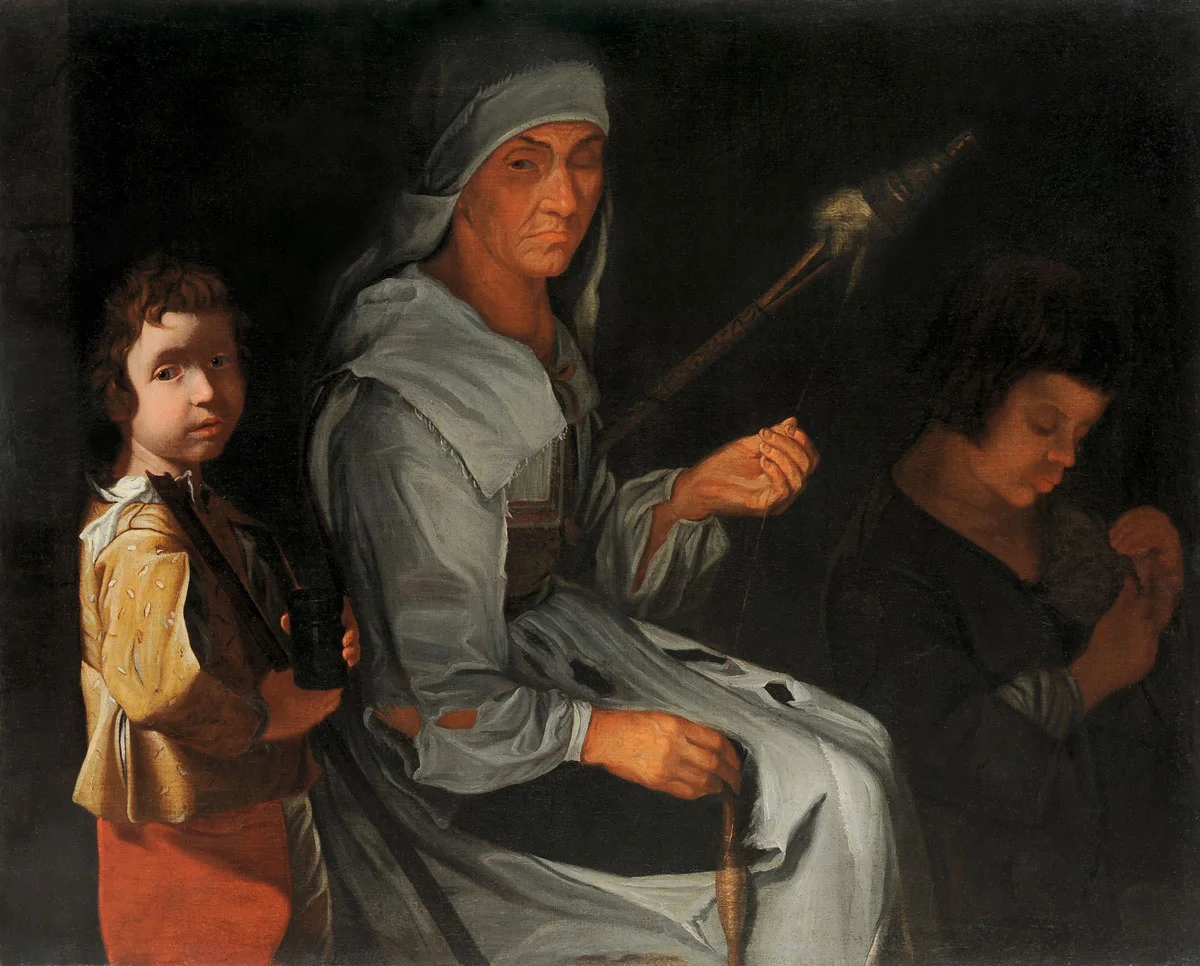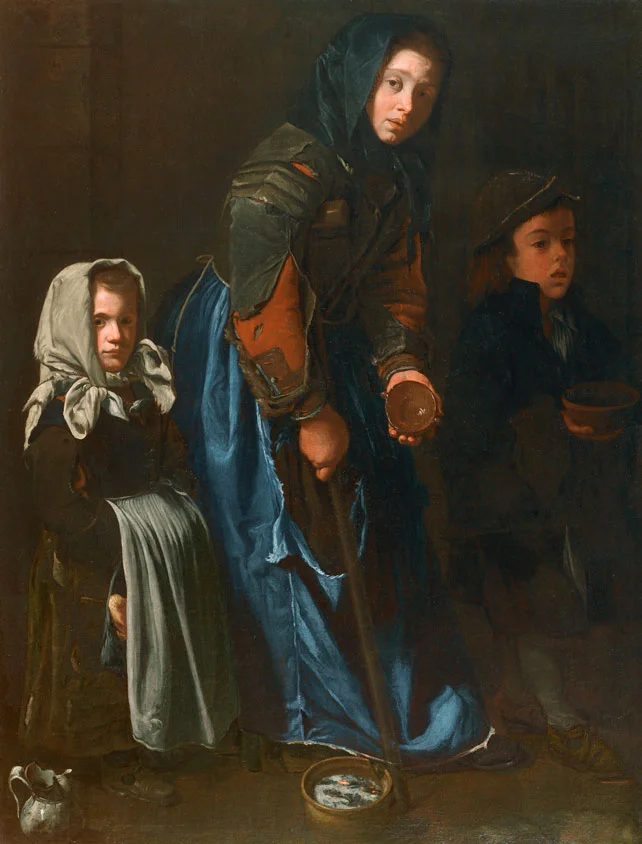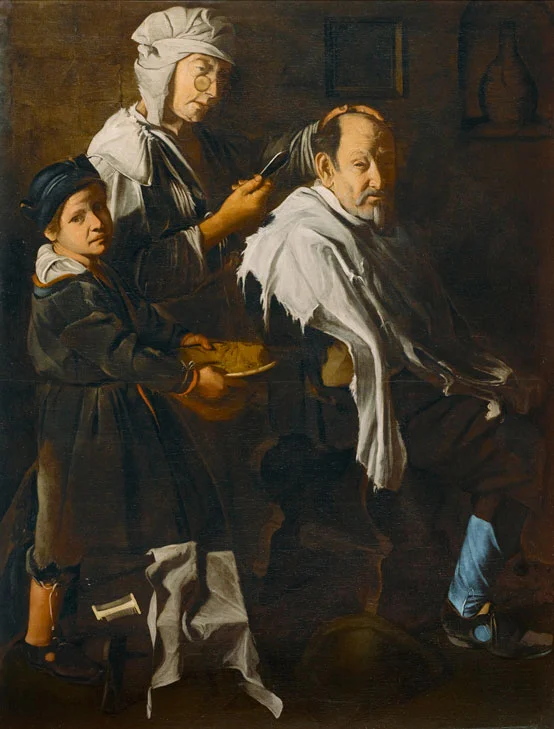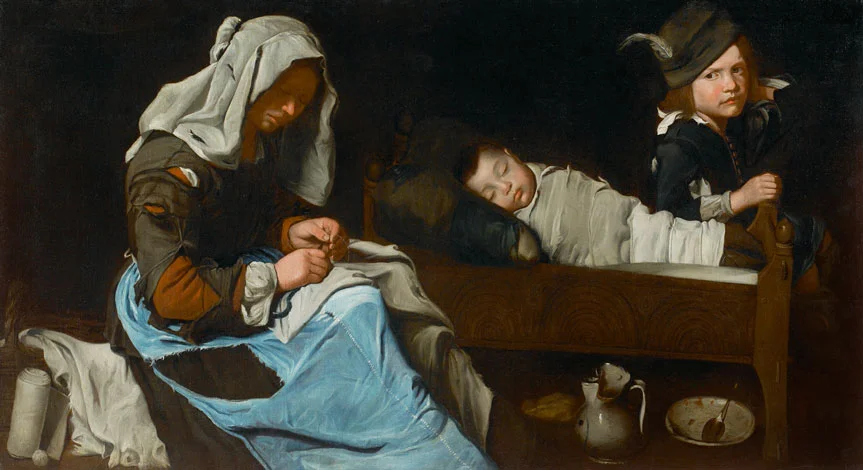
“Woman Spinning with Two Children,” (c. 17th century). Oil on canvas. 35 x 42 inches. Courtesy Galerie Canesso, Paris.

“Woman Begging with Two Children,” (c. 17th century). Oil on canvas. 60 x 46 inches. Courtesy Galerie Canesso, Paris.

“The Barber Shop,” (c. 17th century). Oil on canvas. 59 x 45 inches. Courtesy Galerie Canesso, Paris.

“Beggar Boy with a Piece of Pie,” (c. 17th century). Oil on canvas. 34 x 24 inches. Formerly Galerie Canesso, Paris.

“Woman Sewing with Two Children,” (c. 17th century). Oil on canvas. 39 x 71 inches. Formerly Galerie Canesso, Paris.
[](#)[](#)
Alpha Denim
Into the Archives With the Master Himself
Nothing is more modern and all-American than denim. Or so we thought. A rare group of ten Old Master paintings suggests that European peasants may have worn a fabric that was a clear forerunner to our beloved blue jeans as early as the mid-seventeenth century.
Evidence for the young days of denim was first exhibited by Galerie Canesso in Paris when, in 2010, they displayed the works of an anonymous Northern Italian painter, memorably dubbed by a respected curator as the ‘Master of the Blue Jeans.’ The paintings highlight the colorful, dyed blue and white cotton twill woven fabric as worn by modern peasants in naturalistic scenes. The tattered women’s skirts, boys’ jackets, and men’s leg coverings in the paintings: all denim.
But let’s back up. Jeans were alive and well pre-‘Master of the Blue Jeans.’ The etymology of ‘jeans’ and ‘denim’ can be traced even further across the Atlantic than these paintings. Forms of the word jeans (_gene or jene_) can be found in accounts as early as the sixteenth century and derive from the place name of the Italian city Genoa, where, by some accounts, the cotton-twill fabric (first brown and later dyed) is said to have been conceived to outfit sailors and fishermen. Denim, a related, naturally dyed indigo, cotton twill fabric used for heavy, durable garments, hails from a similar place name, _Serge de Nîmes_ (_de Nîmes_ = from Nîmes, which was eventually shortened to ‘denim’).
Two original styles of the jean pant—blue farm overalls and bulky, less-than-fashionable trousers—made their debut later, in the eighteenth century, and were first popularized by the great nineteenth-century Californian, Levi Strauss, who designed his first durable garments with rivets for cowboys and rail workers of the growing Western frontier. Now denim is in abundance in every social circle, widely embraced by all genders and ages, in high and low fashion. But the comfortable, fading fabric was once exclusively the well-worn stuff of society’s lower and working classes.
The Master of the Blue Jeans collection offers vivid and compelling historical lessons about class and social values in use nearly four hundred years ago. In the images, poor women and ragged yet knowing children are shown as sympathetic characters in humble surroundings, with large holes in their clothing and empty dishes in their hands. At times, they look directly at the viewer, seeking empathy. In other instances, women engage in traditional, domestic activities, such as sewing, hair-cutting, spinning, and tending to children—subjects that Renaissance viewers would have praised as virtuous, ‘women’s work’ necessary for the family’s survival. Painted naturalistically, such quiet, monochromatic scenes emphasized the ‘rough,’ humble virtue and peaceful natures of their low-brow subjects.
Often bathed in Caravaggisti light and usually painted with a high degree of focus, the peasants were often considered less-than-human in early modern Europe. They were also increasingly characterized in contemporary texts for their Christian humility and even their peaceful acceptance of their humble lot in life.
Painting the poor and marginalized as legitimate, virtuous subjects of ‘high art’ was a new phenomenon in the early seventeenth century. Flemish and Dutch genre painters first popularized painting peasants and low-class genre subjects in their tavern and townscape scenes in the late-sixteenth and early-eighteenth centuries, while Flemish, and then Spanish artists took the lead in depicting them as sympathetic, thinking individuals that still simultaneously represented a social class.
What’s more, the über rich, including aristocracy and royalty, coveted such low-brow paintings for their private collections. (Some of the most memorable portraits of dwarfs and jesters hung at the Spanish palace of King Philip IV, for example.) In a period marked by economic decline, war, and a constant threat of peasant uprisings, such paintings, in part, reflected the aristocracy’s growing taste for quiet, charming images of the poorer classes as a means to reinforce social hierarchies and stability in a time of upheaval.
Despite their apparent ‘realism,’ these paintings weave fictions. Look closely—bourgeois details call into question the abject poverty of the subjects. No one actually _works_ in the paintings, and the strikingly clean settings look less like crowded, dirty peasant hovels than simple (perhaps urban?) middle class spaces. Well-placed objects, such as ceramic bowls and pitchers, neat rolls of white fabric, and most notably, a carved, wooden child’s bed—likely too fine and costly for the peasant class—also appear somewhat out of place. Even the prominent denim clothing seems a bit too pressed and carefully ripped, while other sartorial details, like feathered hats and colorful, intentionally slashed sleeves, seem too flamboyant. Likely inspired more by aristocratic values, the growing popularity of swashbuckling, Spanish _picaresque_ novels, and possibly even the growing _bourgeoisie_ than contemporary peasant life, these highly conventionalized paintings cast doubt on how much we can trust what they depict—including the widespread use of their surprising denim fabric by peasants—after all.
